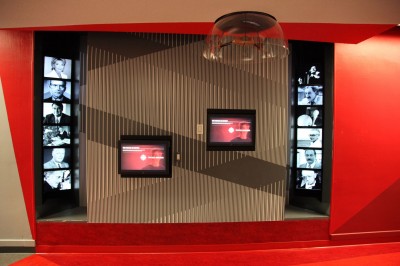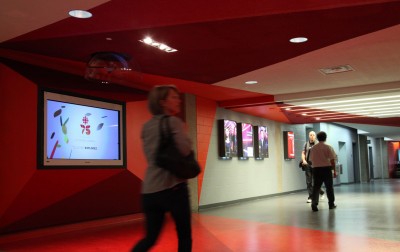By Peter Saunders
As one of Canada’s largest and most storied cultural institutions, the Canadian Broadcasting Corporation (CBC)/Radio-Canada had a wealth of content to showcase in 2011 when the time came to celebrate its 75th anniversary. One new vehicle for this content was an immersive, multi-screen digital signage project at Maison de Radio-Canada, the crown corporation’s regional headquarters in Montreal.
The concept that emerged for this project was to depict the past, present and future. Key moments in Radio-Canada’s history and ongoing development would be made readily accessible through interactive touch screens to the building’s 3,000 employees and 80,000 annual visitors.
The content would take them through a Canadian media journey, from radio and TV to the Internet and evolving social media outlets, including YouTube, Twitter and Facebook. Given CBC/Radio-Canada websites serve more than 7.5 million unique visitors per month, it seemed fitting for web-based media to become a key component of the digital signage.
Streamlining production
As a result, there were initially many stakeholders involved in the project, which caused some unanticipated delays. When Telecine Multimedia—a Montreal-based digital signage content provider and installer—came on board in late June 2011, it faced an aggressive five-week timeline for all creation, testing and implementation. The work would start on July 18 and needed to be completed by August 22, in time for the first in a series of Radio-Canada’s 75th anniversary celebrations.

Telecine Multimedia worked with Radio-Canada to keep content simple and engaging. Some screens use black-and-white photos, for example, to showcase notable past personalities.
So, Telecine enforced a point-person approach to ensure efficiency of communications and project management.
“Our first meetings were with 12 to 14 people,” says James Fine, Telecine’s president. “We were afraid they would all need to be involved in the entire process, but fortunately, Radio-Canada delegated the project to three key people before the work began.”
With services responsible to these three contacts, the company was able to deliver the custom content in a timely manner.
“There was nothing in the programming we hadn’t done before, so it wasn’t earth-shattering,” says Fine, “but it was a lot of interactivity to handle in that tight a timeline. We had to streamline our usual production process, as this kind of work would normally take three to four months.”






